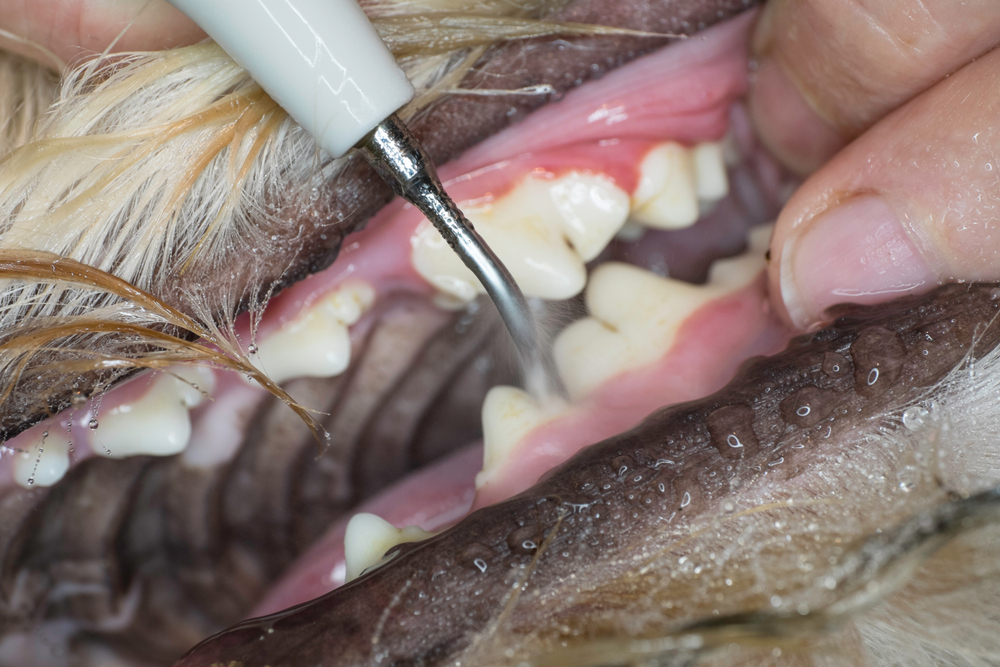At Sale Creek Veterinary Services, we believe your pet’s dental health plays a key role in their overall wellbeing, and can add years to their life. Unfortunately, by age 3, 70% of cats and 80% of dogs show periodontal (i.e., dental) disease signs. Fortunately, with advances in veterinary dentistry, we are now able to provide more proactive dental care to prevent or stop periodontal disease progression.
The high cost of neglecting your pet’s dental health
Periodontal disease is a destructive, inflammatory condition that attacks gum tissue, tooth roots, and the surrounding bone. This sneaky disease exists below the visible tooth crown, hiding in tissue under the gums and accumulating plaque and tartar, so it frequently goes unnoticed. Owners are often alarmed to discover that their pet’s healthy-looking mouth is hiding multiple broken, damaged, and infected teeth that are causing their beloved pet severe pain.
In addition to tooth loss, periodontal disease can trigger cascading effects, including:
- Infection
- Oronasal fistula (i.e., draining tract)
- Tooth root erosion
- Jaw bone erosion
- Heart, liver, and kidney damage — Bacteria from severe periodontal disease enter the bloodstream, travel to these organs, and trigger inflammatory damage.
Routine at-home dental care and annual examinations at Sale Creek Veterinary Services, along with dental cleanings under anesthesia, can reduce the likelihood of these devastating effects. To better understand what goes on during a pet dental cleaning, let’s take a look at the five facets of veterinary dentistry at our hospital.
#1: Pre-anesthetic testing for your pet
Pet owners are often concerned about their pet undergoing anesthesia for a dental cleaning, and may postpone necessary dental treatment because of safety concerns. While we understand this hesitation, anesthesia is actually a key part of veterinary dental safety. Anesthesia allows us to:
- Ensure pet comfort, relaxation, and stillness
- Prevent debris from entering their airway
- Protect our team from bites or injury
- Access the entire oral cavity
- Take dental X-rays
- Clean below the gum line where periodontal disease lives
- Perform uncomfortable procedures
To ensure your pet is healthy enough for anesthesia, we perform specific diagnostic screening tests prior to the dental procedure, which may include:
- Blood work (e.g., complete blood count, general chemistry)
- Chest X-rays
- ECG
- Urinalysis
These test results allow us to correct issues in advance, or tailor our medications to accommodate your pet’s unique health needs.
#2: Safe anesthesia protocols to protect your pet
Modern anesthesia involves a careful balance of sedation and pain control. Your pet’s anesthetic protocol will be customized to suit their age, health, and personality (e.g., nervous-excited or calm). The following standard components are always included:
- Intravenous (IV) catheter
- Pre-anesthetic sedation
- Intubation (i.e., breathing tube)
- Inhalant gas
- Continuous vitals (e.g., heart rate, temperature, blood pressure) monitoring
- IV fluid therapy
#3: Digital X-rays to look below your pet’s gum line
The average dog or cat tooth is similar to an iceberg—the visible crown is only a small portion of what lies beneath the surface. Dental X-rays allow us to see below the gum line and to identify unseen fractures, damaged roots, infection, and bone loss that would otherwise go undiagnosed. Check out the dentistry section of our services page or our previous blog post for an excellent illustration.
Dental X-rays are instrumental in the early diagnosis of periodontal disease, bony cancers, and painful subgingival pathology. They help your pet’s veterinarian make informed decisions about which teeth should be extracted (i.e., removed), and which can be saved with therapeutic treatment or referral to a veterinary dental specialist.
#4: Detailed scaling and polishing of your pet’s teeth
Each tooth is individually scaled with an ultrasonic scaler—a high-tech hand tool that uses sound waves to break up the concrete-like bonds that hold tartar to your pet’s teeth. Unlike manual instruments, the ultrasonic scaler can safely flush plaque and bacteria from the unseen pockets below the gum line between the gum and the tooth.
After the thorough scaling, each tooth is polished, an essential step that smooths the microscopic grooves created by scaling. If left unpolished, new bacteria will adhere to these tiny crevices.
#5: Your pet’s oral examination and treatment

Following X-rays and cleaning, your pet’s veterinarian performs a thorough oral cavity examination, paying special attention to these areas:
- Each tooth and its surrounding gingiva
- Periodontal pockets
- The hard and soft palates
- The tongue
- The upper airway
- Areas of abnormal or excessive tissue, which may indicate cancer
After the examination, your pet’s veterinarian will use their findings, along with X-ray images, to develop a customized treatment plan. They will communicate their findings to you, and then proceed with the approved services, which may include dental extractions, application of antibiotics or sealant, tissue biopsy, or therapeutic procedures to preserve at-risk teeth.
Prior to any painful procedure, your pet will receive a local anesthetic to numb the area. Additional pain medication will be prescribed to administer at home. Generally, pets handle dental surgery well, and experience fast relief once the affected tooth is removed. After dental surgery, your pet can eat soft food only, until their recheck in 7 to 14 days—at which point, most pets can return to their normal diet.
Protect your pet from periodontal disease
If you haven’t lifted the lip on your pet’s dental health for a while, take a look—if you notice bad breath, inflammation, sensitivity, excessive tartar, or visibly damaged teeth, contact Sale Creek Veterinary Services for a dental health assessment and cleaning under anesthesia.







Leave A Comment